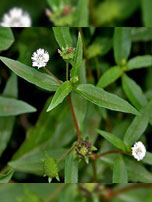SHAHEED KARTAR SINGH SARABHA AYURVEDIC MEDICAL COLLEGE & HOSPITAL
Affiliated to Guru Ravidas Ayurved University, Hoshiarpur Punjab
Affiliated to Guru Ravidas Ayurved University, Hoshiarpur Punjab

Botanical Name : Eclipta alba (Linn.) Hassk.
Family : Compositae; Asteraceae
Introduction :
This drug used as hair tonic at present its hepatoprotective role is well established and used in hepatitis. Caraka, Susruta & Vagbhata did not classify this herb
Names in different Indian languages :
Hindi : Bhangra, mocakand, Bari
Telugu : Guntagalagaraku
Tamil : Kayanthakara, kaikesi
English : Trailing eclipta
Bengali : Kesuriya
Punjabi : Bhangra
Marathi : Maka
Gujarati : Bhangaro
Kanada : Garagada soppu
Malayalam : Kannunni, kayyonni, kayunni
Sanskrit : Bhringaraaja
Unani : Bhangraa
Synonyms :
Bhringa, Bhringaja, Bhrngaaraka, Bhrngaara, Maarkava, Kesharaaja, Keshranjana
Eclipta prostrate (L) L.
Verbesina prostrataL.J
Varieties & adulterants – (CV – controversy, AD – adulterants) :
1. Pita Bhgarãja used in Kerala.
2. Rakta Bhrngarãia – Flaviera rependa.
3. Wedelia calendulacea
4. White (Sveta bhrangaraja) – E. alba
5. Yellow(Pita bhrngaraja) – Wedelia chinensis – [CV]
6. Blue – no identity
Morphology :
An erect annual herb having height 8-10 fingers. Rooted nodes.
Leaves- simple, opposite, sessile, 2.5-7.5 cm long, variable in breadth, oblong- lanceolate, subentire, acute or subacute, strigose.
Flowers- white, in heads 6-8 mm. diameter, solitary or two on unequal axillary peduncles. Involucres bracts about 8. Ray-flowers ligulate, white. Disk-flowers tubular, corolla 4-toothed
Fruit- achene, cuneate, compressed and with a narrow wing.
W. calendulacea
Leaves – 3- 5 cm in length. 1.5—2 cm. in breadth, having serrated margins.
Flower stalk- elongated having white flower on its tip.
Seed – black, elongated. like black cumin seed. A single fruit has many seeds. These herbs grow in rainy season and bear flowers and fruits in autumn. Maka should be used in autumn or after that Annual, erect or prostrate herb, rooting at the nodes.
Distribution & Habitat :
All over India in moisture, especially near the fields and water sources.
Chemical Composition :
It contains resin Ecliptal, wedelolactone, desmethyl wedelolactone, stigmasterol; heptacosanol, hentriacontaflol, sixteen polyacetylenic thiophenes etc.
Properties :
Rasa Katu, Tikta
Guna Ruksa, Laghu
Virya Usna
Vipaka Katu
Karma : Kapha-vãta hara, Kesya, Rasayana, Balya, Caksusya, Dantya.
Anti inflammatory, diuretic, antihepatotoxic, anticatarrhal, febrifuge
Part Used :
Whole plant
Dosage :
Fresh juice 5-10 ml.
Indications : Pãndu, Kãmalã, Svãsa, Kasa, Netra roga, Hrdroga, Krmi, Kustha, sotha, sirah süla.
anorexia, jaundice, hypertension, otalgia, anorexia, cephalgia, pruritis, blackening and strengthening of the hair, it is believed that its seeds are good for increasing sexual vigour.
External uses :
The herb alleviates swelling and pain, cleans and heals wounds, enhances complexion. But its man action is to promote hair growth and hair dye. Its paste reduces swelling and pain when applied over filariasis, glands, wounds and chronic ulcers. It helps in healing wounds and gives natural complexion to the skin. Drops of its juice are put in eyes and ear. It relieves conjunctivitis if applied in eyes and earache, if applied in car. The juice is applied over head to relieve headache. In migraine, bhrungaraj juice and goat’s milk are used as nasal drops. Grey hair turns to black, if juice is applied over scalp.
Internal uses :
Central nervous system : Alleviates vata and acts as an analgesic. It is used in diseases like headache, vertigo etc. Bhrungaraj is effective in various vata disorders.
Eyes : It improves vision. It is used in night blindness and myopia.
Digestive system : Bhrungaraj is an excellent appetizer, digestant and liver stimulant. Its main action is on liver (and spleen). It improve the bilious flow. It is ama digestant, anthelmintic and
Properties (gunas) can be recognized by actrities (karmas) and dravyas are recognized by their gunas.
A mixture of Eclipta juice and castor oil is a good vermicide. It reduces mucous in the stool and foul smell. Overall. Eclipta can be described as a best medicine for digestive system.
Circulatory system : As it purifies blood, increases blood, reduces blood pressure and oedema.’ it is useful in blood disorders, anaemia. oedema and hypertension.
Respiratory system : Being an expectorant and raktagami. it is used in cough and asthma.
Urinary system Kaphamedagami – It acts as a diuretic by alleviating kapha and meda. It reduces burning micturation. Mixture of roots and leaves + ajamoda is useful in all urinary disorders.
Reproductive system : Its seeds are shukragami and spermatogenic. Hence it is used for virilisation.
Satmikaran : It promotes immunity and has rejuvenating action in anaemia and lipid disorders But blue bhrungaraj should be used for rejuvenation.
Skin : It has diaphoretic action because it is rasa, rakta,. Useful in skin disorders, kilas urticaria, kshudrarogas. Also enhances complexion.
Temperature : Diaphoretic. Being ama digestant and being febrifuge, it is effective in many fevers like typhoid and malarial fever.
Important Yogas or Formations :
Bhrungaraj taila, Shadbindutaila, Bhrungarajadi churna, Bhrungarajghrit. Bhrungarajasava. Nilibhrngadi taila, adbindu taila
Important research work going on :
(1) antiviral activity
(2) toxic hepatic injury
(3) in vitro
(4) Action on liver
Therapeutic Uses :
(1) Garbhasthãpana- Cow milk with equal quantity of Bhrnga rãja svarasa should be given to pregnant woman (Vai.Ma.).
(2) Svitra- Bhrngaraja is fried with oil in an iron vessel is consumed and after that milk boiled with Bijaka shall be given as Anupãna (A.H.Ci.20).
(3) Naktäñdhyatva- Matsyãndas boiled in Bhrñgaraja svarasa when consumed for a period of seven days will cure night blindness (C.D.).
